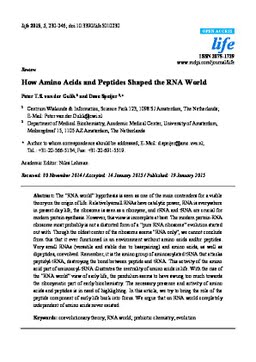2015-01-19
How amino acids and peptides shaped the RNA World
Publication
Publication
Life , Volume 5 - Issue 1 p. 230- 246
The “RNA world” hypothesis is seen as one of the main contenders for a viable
theory on the origin of life. Relatively small RNAs have catalytic power, RNA is everywhere
in present-day life, the ribosome is seen as a ribozyme, and rRNA and tRNA are crucial for
modern protein synthesis. However, this view is incomplete at best. The modern protein-RNA
ribosome most probably is not a distorted form of a “pure RNA ribosome” evolution started
out with. Though the oldest center of the ribosome seems “RNA only”, we cannot conclude
from this that it ever functioned in an environment without amino acids and/or peptides.
Very small RNAs (versatile and stable due to basepairing) and amino acids, as well as
dipeptides, coevolved. Remember, it is the amino group of aminoacylated tRNA that attacks
peptidyl-tRNA, destroying the bond between peptide and tRNA. This activity of the amino
acid part of aminoacyl-tRNA illustrates the centrality of amino acids in life. With the rise of
the “RNA world” view of early life, the pendulum seems to have swung too much towards
the ribozymatic part of early biochemistry. The necessary presence and activity of amino
acids and peptides is in need of highlighting. In this article, we try to bring the role of the
peptide component of early life back into focus. We argue that an RNA world completely
independent of amino acids never existed.
| Additional Metadata | |
|---|---|
| , , , | |
| MDPI AG | |
| Life | |
| Organisation | Algorithms and Complexity |
|
van der Gulik, P., & Speijer, D. (2015). How amino acids and peptides shaped the RNA World. Life, 5(1), 230–246. |
|

